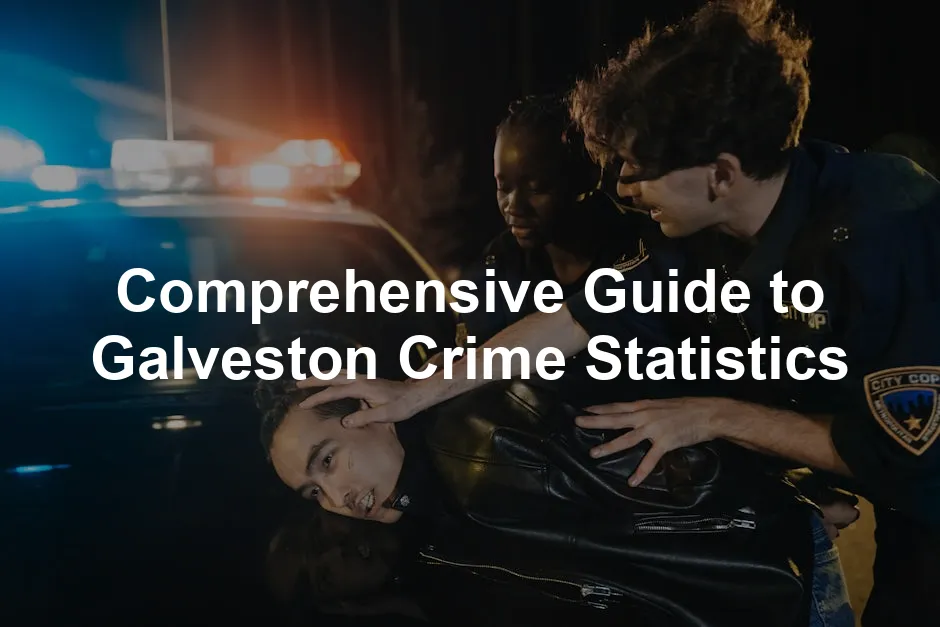Introduction
Galveston, Texas, is a charming coastal city located in Southeast Texas. Known for its beautiful beaches, historic architecture, and vibrant culture, it draws tourists from all over. The island is just 50 miles from Houston, making it a popular getaway for city dwellers. Whether you’re lounging on the beach or exploring the local shops, Galveston offers something for everyone.
However, like many urban areas, Galveston grapples with crime. Understanding crime statistics is crucial for both residents and visitors. These statistics provide insights into safety, helping people make informed decisions. For residents, it fosters awareness and promotes community engagement. Visitors can feel more secure knowing what to expect.
This article aims to present up-to-date and comprehensive crime statistics for Galveston. By analyzing recent data, we’ll shed light on safety concerns and community perceptions. Let’s dive into the numbers to understand what they mean for the everyday lives of Galveston’s residents and its many visitors.
Understanding Crime Statistics in Galveston
What Are Crime Statistics?
Crime statistics are numerical data that reflect the frequency and types of crimes committed within a specific area. They play a vital role in urban planning and community safety. Policymakers and law enforcement agencies use these statistics to allocate resources effectively and develop strategies to reduce crime. If you’re interested in a deeper dive into how crime affects communities, check out “Crime and Justice: A History of the American Criminal Justice System”. It’s a page-turner that will have you questioning everything!
Crime statistics are collected and reported by various agencies, including local police departments. Each agency compiles data on reported crimes, which is then categorized by type. This includes violent crimes, such as assault and murder, as well as property crimes like burglary and theft. The information is then aggregated to provide a clear picture of crime trends in a city or region.
Understanding crime statistics is essential for assessing safety levels in Galveston. They can help identify patterns and trends, allowing residents and visitors to stay informed. With accurate data, communities can work together to enhance safety measures and create a more secure environment.
Current Crime Trends in Galveston
As of 2022-2023, Galveston has a total crime rate of 35.47 per 1,000 residents. This figure indicates a higher risk compared to many other Texas communities. In fact, over 94% of Texas communities report lower crime rates than those in Galveston.
The violent crime rate stands at 4.71 per 1,000 residents, which includes serious offenses such as murder, rape, robbery, and assault. While this number may sound alarming, it’s essential to consider it in context. Many cities across the nation experience similar or even higher rates.
When it comes to property crime, Galveston has a rate of 30.76 per 1,000 residents. This category encompasses theft, burglary, and motor vehicle theft. These statistics highlight a pressing issue for the community. Understanding these trends can empower residents to take proactive measures to enhance their safety and that of their neighbors. A comprehensive guide like “The Crime Book: Big Ideas Simply Explained” can provide context for these figures.
Understanding property crime rates can help Galveston residents make informed decisions about their safety. Fremont crime statistics offer a comparative analysis of safety in different communities.
In comparison to the state and national averages, Galveston’s crime rates reveal a nuanced picture. The data indicates that while crime is prevalent, there are also areas within the city that maintain a strong community focus on safety. By keeping informed about these trends, residents can work together to foster a safer Galveston.

Breakdown of Violent Crimes
Types of Violent Crimes
Galveston has its share of violent crimes, and the statistics reveal a concerning reality. In recent reports, the city had:
- Murder: 6 cases.
- Rape: 64 cases.
- Robbery: 38 cases.
- Assault: 142 cases.
Let’s break these numbers down further.
First up, murder. With only 6 cases, it might seem relatively low. Yet, each case represents a life lost, making it a significant concern for the community. This statistic translates to a murder rate of 0.11 per 1,000 residents. A somber reminder that even in a vibrant city, the darkest shadows exist.
Now, let’s tackle rape. The 64 reported cases yield a rate of 1.21 per 1,000 residents. This figure raises red flags. It highlights the necessity for increased awareness, education, and support for victims. Consider reading “The Gift of Fear: And Other Survival Signals That Protect Us from Violence” for valuable insights on personal safety.
Robbery, with 38 cases, reveals both opportunistic crime and the challenges faced by law enforcement. The robbery rate here is about 0.72 per 1,000 residents. It’s a wake-up call for residents to stay vigilant and report suspicious activities.
Assault remains the most prevalent violent crime, with 142 cases, translating to 2.67 per 1,000 residents. This statistic indicates a pattern that needs addressing. Community programs and local initiatives are crucial for fostering a safer environment. You might find “Community Policing: Partnerships for Problem Solving” helpful in understanding community-driven safety initiatives.
Comparative Analysis
Now, let’s see how Galveston stacks up against state and national averages. The violent crime rate in Galveston stands at 4.71 per 1,000 residents, which is slightly above Texas’s average of 4.32 and the national median of 4. The numbers suggest that Galveston is experiencing a level of violence that surpasses many areas.
In recent years, the trend has shown fluctuations. For instance, the overall violent crime rate has dipped in some areas while surging in others. Notably, the number of assaults has decreased compared to previous years. However, the rates of rape and robbery remain stubbornly high, indicating persistent issues that need attention.
To give a clearer picture, let’s visualize the data in a table:
| Crime Type | Galveston | Texas | National Median |
|---|---|---|---|
| Violent Crime | 4.71 | 4.32 | 4 |
This table illustrates the concerning reality that, while Galveston’s overall violent crime rate is lower than some areas, specific types of crime still pose significant risks.
The data indicates that Galveston has a higher chance of violent crime victimization compared to many Texas communities. The chance of becoming a victim of a violent crime in Galveston is about 1 in 212, a figure that should encourage residents to be proactive in community safety measures. Consider investing in a Personal Safety Alarm with LED Flashlight to enhance your personal safety while out and about!
In summary, while Galveston boasts beautiful beaches and vibrant culture, the violent crime statistics paint a more complex picture. Understanding these figures helps residents and visitors alike stay informed and prepared. Building community awareness and support systems will be vital in reducing these crime numbers and ensuring a safer environment for all.

Breakdown of Property Crimes
Types of Property Crimes
When it comes to property crimes, Galveston also faces significant challenges. The statistics here are telling:
- Burglary: 203 cases.
- Theft: 1,219 cases.
- Motor Vehicle Theft: 211 cases.
Let’s examine these figures closely.
Starting with burglary, the 203 reported cases indicate a burglary rate of 3.82 per 1,000 residents. Burglary can leave residents feeling vulnerable in their own homes. This statistic highlights the need for stronger community engagement and preventive measures. You can enhance your home’s security with a Home Security Camera System to keep an eye on your property.
Theft, however, is the real heavyweight here. With a staggering 1,219 cases, theft accounts for a rate of 22.96 per 1,000 residents. This figure is alarming and suggests that theft is a rampant issue. It raises concerns about the economic factors that may contribute to such high numbers. Consider preventative measures like a Bicycle Lock with Alarm to protect your valuables.
Motor vehicle theft has also been a notable concern with 211 cases, translating to a rate of 3.97 per 1,000 residents. This statistic serves as a reminder for vehicle owners to remain vigilant. Investing in anti-theft measures can go a long way in protecting personal property. Don’t forget about a Fire Extinguisher for Home Safety just in case things heat up!

Comparative Analysis
Now, comparing property crime rates to other areas, Galveston shows significantly higher rates. The property crime rate stands at 30.76 per 1,000 residents, far exceeding the Texas average of 23.0 and the national median of 20.
To visualize this disparity, consider the following table:
| Crime Type | Galveston | Texas | National Median |
|---|---|---|---|
| Property Crime | 30.76 | 23.0 | 20 |
These statistics underline a pressing issue for residents and city officials. Understanding these trends allows for targeted intervention strategies. Recent years have seen increases in theft and burglary rates. This suggests that the community must address underlying economic issues to reduce property crime.
In summary, the property crime statistics in Galveston depict a city facing persistent challenges. Residents must remain aware and proactive in preventing theft and burglaries. Building strong community networks and engaging local law enforcement can help foster a safer environment for everyone.


Neighborhood Safety Insights
Safe vs. High Crime Areas
Not all neighborhoods in Galveston are created equal. Some are like cozy nooks, while others feel a bit more like the wild west. Take Jamaica Beach and Sea Isle, for example. These sunny spots are known for their low crime rates, making them popular choices for families and retirees. Residents here often feel a sense of safety, enjoying beach days without a worry.
On the flip side, neighborhoods like the Galveston Townsite and Lindale Park have higher crime rates. The contrast is stark. Residents in these areas may express concerns about safety, especially when it comes to property crimes.
The disparities in crime rates can often be attributed to a variety of factors, including socio-economic status, access to education, and community programs. Neighborhoods with strong community ties and active policing tend to fare better in terms of safety. It’s crucial for potential residents to research these differences carefully.

Community Sentiment and Safety Perception
Community sentiment plays a significant role in shaping the safety perception in Galveston. A recent survey revealed that only 31% of residents feel secure in their neighborhoods. That leaves 69% feeling a bit more apprehensive, especially when walking alone at night.
Local initiatives, such as community policing and neighborhood watch programs, have gained traction. These efforts help foster a sense of camaraderie among residents and build trust between law enforcement and the community. When residents feel their voices are heard, they’re more likely to engage in safety measures.
Moreover, local events aimed at strengthening community ties have also been shown to positively impact crime rates. When people know their neighbors and feel connected, they’re more likely to look out for one another. This connection can deter crime and create a safer environment for everyone.
In summary, while Galveston does face crime challenges, there are bright spots. It’s essential to remain informed about neighborhood specifics and actively participate in community safety initiatives. By doing so, residents can contribute to a safer Galveston for all.

Crime Prevention Strategies and Resources
Local Law Enforcement Efforts
The Galveston Police Department (GPD) knows that crime doesn’t take a vacation, even in a beautiful beach town. To tackle this issue, GPD has launched several initiatives aimed at reducing crime and fostering a safer community. One of their key strategies is community engagement. The department actively encourages residents to participate in local events and meetings, strengthening the bond between officers and the community.
Neighborhood watch programs have become a cornerstone of crime prevention efforts in Galveston. These programs empower residents to take an active role in their safety. With trained volunteers keeping an eye out for suspicious activity, neighborhoods can proactively deter crime. Think of it as a friendly neighborhood superhero squad, minus the capes!
Additionally, GPD has implemented crime prevention strategies that focus on education. Workshops and seminars educate residents on crime trends, personal safety, and effective reporting methods. By equipping the community with knowledge, Galveston fosters a proactive approach to crime prevention. The department also utilizes social media to keep residents informed about local crime statistics and tips for staying safe.
In essence, the Galveston Police Department is committed to making safety a community affair. Their efforts showcase the importance of collaboration between law enforcement and residents. Together, they can create a safer environment for everyone.

Resources for Residents
For those living in Galveston, it’s crucial to know where to turn for help and support. Here’s a handy list of resources available to residents:
- Galveston Police Department: The primary law enforcement agency in Galveston, reachable at (409) 765-3702 for emergencies or non-emergencies.
- Crime Stoppers: An anonymous tip line that rewards individuals for reporting crime information. Call (409) 763-8477 to report tips without fear of retribution.
- Neighborhood Watch Programs: Interested in starting or joining a neighborhood watch? Reach out to your local police precinct for more information.
- Local Hotlines: For immediate assistance, residents can contact local hotlines for support. This includes domestic violence shelters, mental health services, and substance abuse resources.
- Community Organizations: Groups like the Galveston Chamber of Commerce and local nonprofits often host safety workshops and outreach programs.
- Safety Apps: Consider downloading safety apps like “Citizen” or “Nextdoor” for real-time safety alerts and community updates. You might also want to check out a Emergency Preparedness Kit for peace of mind!
By leveraging these resources, residents can stay informed and engaged in crime prevention efforts. After all, safety is a team sport, and every resident plays a vital role in keeping Galveston safe and sound.

Conclusion
In summary, understanding crime statistics in Galveston is not just about numbers. It’s about fostering a sense of community and safety. The data shows that while Galveston faces challenges with higher crime rates, proactive measures can make a significant difference.
Awareness is the first step toward safety. Residents should stay informed about local crime trends and participate in community initiatives. With programs like neighborhood watch and law enforcement engagement, everyone can contribute to a safer Galveston.
Moreover, the importance of community involvement cannot be overstated. Engaging with local resources, attending meetings, and reporting suspicious activities can create a ripple effect of safety. The more vigilant residents are, the safer the overall environment becomes.
Ultimately, safety in Galveston is a collective effort. By encouraging a strong sense of community and fostering communication between law enforcement and residents, Galveston can work toward reducing crime rates. Together, they can transform the island into a safer haven for both residents and visitors alike. So, let’s roll up our sleeves and get involved—safety starts with us!
FAQs
Is Galveston safe for tourists?
Galveston is a delightful beach town that welcomes many visitors. While it has its quirks, it’s generally safe for tourists. Most areas are bustling with families and beachgoers, especially near the Strand and Seawall. However, like any city, it’s wise to stay alert. Stick to well-lit areas, especially at night, and keep your belongings close. Families can enjoy spots like Jamaica Beach and Sea Isle, known for their lower crime rates.
What should I do if I become a victim of crime in Galveston?
First, take a deep breath. Then, prioritize your safety. If you’re in immediate danger, dial 911. For non-emergencies, contact the Galveston Police Department at (409) 765-3702. They’ll guide you through the next steps. It’s also crucial to report the crime, even if it seems minor. This helps law enforcement track crime trends and can assist in recovering lost items. Consider reaching out to local support services for emotional or legal guidance.
How does Galveston’s crime rate compare to other Texas cities?
When stacked against other Texas cities, Galveston’s crime rate reveals some eye-opening stats. With a total crime rate of 35.47 per 1,000 residents, it’s higher than the Texas average. Cities like Texas City and La Marque have lower rates, while places like Houston can be more volatile. Essentially, Galveston falls into the higher tier of crime rates compared to neighboring cities, but it still offers safe havens within its borders.
Are there any specific neighborhoods to avoid in Galveston?
Yes, while Galveston has lovely spots, some neighborhoods have higher crime rates. Areas like Galveston Townsite and Lindale Park are known for elevated crime levels. It’s wise for potential residents and visitors to research neighborhoods before settling down or exploring. Always check local crime maps and talk to locals for the latest intel. Knowledge is your best friend in avoiding trouble!
What resources are available for crime victims in Galveston?
Galveston offers numerous resources for crime victims. The Galveston Police Department provides assistance and support. Additionally, Crime Stoppers allows you to report information anonymously. Organizations like the Galveston Area Chamber of Commerce often host community safety workshops. Local nonprofits also provide emotional support and legal assistance for victims. Remember, you’re not alone in this—help is available at your fingertips!
Please let us know what you think about our content by leaving a comment down below!
Thank you for reading till here 🙂
All images from Pexels




